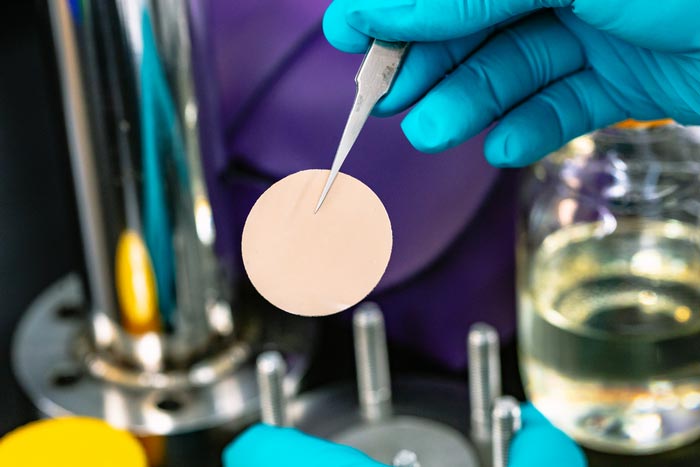Greening hydrocarbon separation and crude oil refining

An organic polymer membrane developed my KAUST scientists offers a greener and more sustainable way to separate hydrocarbon mixtures.
Credit:© 2022 KAUST; Anastasia Serin
Polymer-based membranes developed at KAUST could enable greener and cheaper industrial separation approaches. Their stability and selectivity can be tuned by thermal crosslinking to separate simple hydrocarbon mixtures and complex crude oil fractions.
Separation processes, such as distillation and evaporation, are central to the chemical, pharmaceutical and petrochemical industries, but they are also energy intensive, expensive and polluting. Each year, crude oil refineries consume about one percent of the total energy used worldwide, and some refineries can even release up to 20 to 35 million tonnes of carbon dioxide (CO2) into the atmosphere.
“Decreasing greenhouse gas emissions is a step forward in addressing climate change,” says lead author Stefan Chisca, a research scientist at KAUST. Membranes, with their low carbon footprint and ability to fit in small spaces, offer an attractive alternative to these heat-based processes and can reduce the CO2 emissions of crude oil refineries.
Polymer membranes are cheaper and easier to manufacture and adapt to large-scale processes than inorganic membranes. Yet, their low stability under harsh industrial conditions, such as elevated temperature and certain solvents, affects their performance.
The researchers chose the polymer polytriazole — bearing hydroxyl functional groups as a stable backbone — for their membrane. They deposited the polymer dissolved in various solvents onto a glass plate and immersed the support in distilled water to remove the resulting film. Next, they heated the film in a furnace to crosslink the hydroxyl groups and generate a membrane stable in organic solvents as well as in highly acidic and basic media.
Crosslinking is necessary for challenging applications and must provide stability in the broadest range of conditions, explains team leader Suzana Nunes. “The key to obtaining membranes that could resist harsh environments like crude oil is the presence of the hydroxyl groups,” she says.
The membranes enriched hydrocarbon mixtures by up to 95 percent in compounds containing less than ten carbons. They showed higher selectivity toward paraffins over aromatics, allowing the researchers to target different crude oil mixtures.
“Another crucial factor for the success of these membranes is their asymmetric porous morphology,” Nunes says. The top surface of the membranes presented an ultrathin dense layer consolidated by crosslinking, providing size selectivity. The underlying layers showed a highly porous structure with open interconnected pores that gradually increased with increasing depth to enable permeation.
Chisca explains that the team is now scaling up the membranes and manufacturing test modules for pilot plants. Incorporating a polytriazole membrane unit into existing refineries can improve these processes by producing higher purity components or removing byproducts while reducing energy consumption.
Journal: Science
DOI: 10.1126/science.abm768
Article Title: Polytriazole membranes with ultrathin tunable selective layer for crude oil fractionation
Article Publication Date: 3-Jun-2022
Media Contact
Michael Cusack
King Abdullah University of Science & Technology (KAUST)
michael.cusack@kaust.edu.sa
Office: 009660128083040
Expert Contact
Suzana Nunes
King Abdullah University of Science and Technology (KAUST)
suzana.nunes@kaust.edu.sa
All latest news from the category: Life Sciences and Chemistry
Articles and reports from the Life Sciences and chemistry area deal with applied and basic research into modern biology, chemistry and human medicine.
Valuable information can be found on a range of life sciences fields including bacteriology, biochemistry, bionics, bioinformatics, biophysics, biotechnology, genetics, geobotany, human biology, marine biology, microbiology, molecular biology, cellular biology, zoology, bioinorganic chemistry, microchemistry and environmental chemistry.
Newest articles
Faster, more energy-efficient way to manufacture an industrially important chemical
Zirconium combined with silicon nitride enhances the conversion of propane — present in natural gas — needed to create in-demand plastic, polypropylene. Polypropylene is a common type of plastic found…

Energy planning in Ghana as a role model for the world
Improving the resilience of energy systems in the Global South. What criteria should we use to better plan for resilient energy systems? How do socio-economic, technical and climate change related…

Artificial blood vessels could improve heart bypass outcomes
Artificial blood vessels could improve heart bypass outcomes. 3D-printed blood vessels, which closely mimic the properties of human veins, could transform the treatment of cardiovascular diseases. Strong, flexible, gel-like tubes…




















